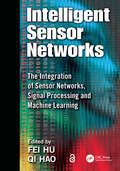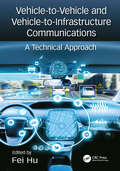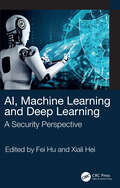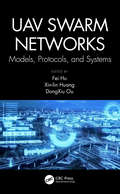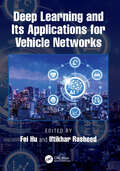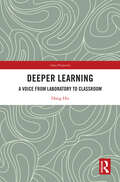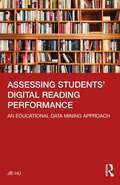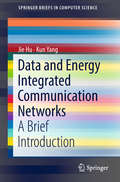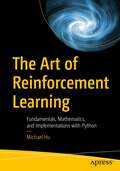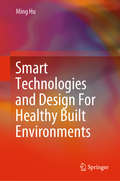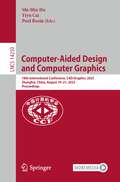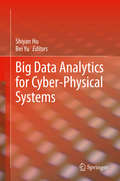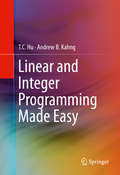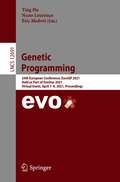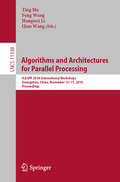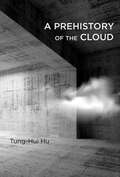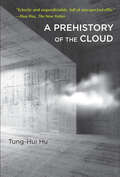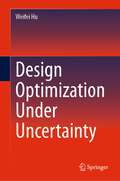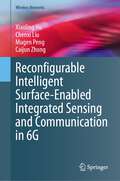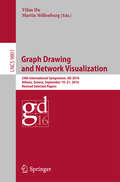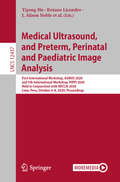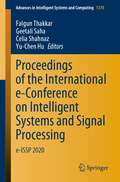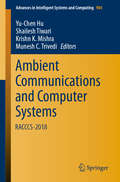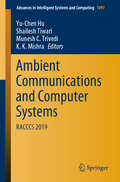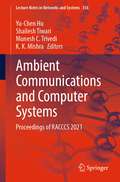- Table View
- List View
Intelligent Sensor Networks: The Integration of Sensor Networks, Signal Processing and Machine Learning
by Fei HuIn the last decade, wireless or wired sensor networks have attracted much attention. However, most designs target general sensor network issues including protocol stack (routing, MAC, etc.) and security issues. This book focuses on the close integration of sensing, networking, and smart signal processing via machine learning. Based on their world-class research, the authors present the fundamentals of intelligent sensor networks. They cover sensing and sampling, distributed signal processing, and intelligent signal learning. In addition, they present cutting-edge research results from leading experts.
Vehicle-to-Vehicle and Vehicle-to-Infrastructure Communications: A Technical Approach
by Fei HuThis book focuses on the most critical technical aspects of vehicle-to-vehicle (V2V) and vehicle-to-infrastructure (V2I) communications. It covers the smart city concept and architecture and explains how V2V and V2I fit into it. It describes the wireless communication protocols for V2V and V2I. It then explains the hardware design process for vehicle communication transceiver and antenna systems. It explains next-generation wireless technologies and their requirements for vehicle communication protocols. Case studies provide the latest V2V and V2I commercial design details. Finally, it describes how to implement vehicle communication protocol from practical hardware design angle.
AI, Machine Learning and Deep Learning: A Security Perspective
by Fei Hu Xiali HeiToday, Artificial Intelligence (AI) and Machine Learning/ Deep Learning (ML/DL) have become the hottest areas in information technology. In our society, many intelligent devices rely on AI/ML/DL algorithms/tools for smart operations. Although AI/ML/DL algorithms and tools have been used in many internet applications and electronic devices, they are also vulnerable to various attacks and threats. AI parameters may be distorted by the internal attacker; the DL input samples may be polluted by adversaries; the ML model may be misled by changing the classification boundary, among many other attacks and threats. Such attacks can make AI products dangerous to use. While this discussion focuses on security issues in AI/ML/DL-based systems (i.e., securing the intelligent systems themselves), AI/ML/DL models and algorithms can actually also be used for cyber security (i.e., the use of AI to achieve security). Since AI/ML/DL security is a newly emergent field, many researchers and industry professionals cannot yet obtain a detailed, comprehensive understanding of this area. This book aims to provide a complete picture of the challenges and solutions to related security issues in various applications. It explains how different attacks can occur in advanced AI tools and the challenges of overcoming those attacks. Then, the book describes many sets of promising solutions to achieve AI security and privacy. The features of this book have seven aspects: This is the first book to explain various practical attacks and countermeasures to AI systems Both quantitative math models and practical security implementations are provided It covers both "securing the AI system itself" and "using AI to achieve security" It covers all the advanced AI attacks and threats with detailed attack models It provides multiple solution spaces to the security and privacy issues in AI tools The differences among ML and DL security and privacy issues are explained Many practical security applications are covered
UAV Swarm Networks: Models, Protocols, and Systems
by Fei Hu DongXiu Ou Xin-Lin HuangUAV swarm network has been used in many critical applications such as disaster recovery, area surveillance, weather monitoring, military communications, etc. There are many challenging R&D issues in UAV network designs, such as the hardware/software integration for a large-scale UAV network management, long-distance data transmissions across UAVs, swarm shape/formation control, intelligent UAV mobility/position prediction, and so on. This book will be the first one to cover the engineering designs (especially network protocol designs) for dynamic, large-scale UAV network. It has the technical models/algorithms and protocol specifications for practical UAV swarm network deployment. · Chapters written by professors, researchers, engineers, and experts in UAV networking fields; · Detailed network protocol descriptions for practical engineering designs; · Covers 7-layer protocols (particularly data routing layer); · Novel AI models/algorithms for intelligent UAV swarming/networking control; · Practical hardware/software implementations for advanced UAV networks. This book is suitable to a variety of audiences: (1) Industry UAV R&D engineers, administrators, or technicians, who would like to grasp the latest trends in UAV communications; (2) College graduate students or researchers, who may want to pursue some advanced research on large-scale UAV swarming and networking technologies; (3) government agencies which determine the future society development in this exciting field; and (4) other interested readers with strong desire to understand the challenges of designing an QoS-oriented UAV network. Book editors: (1) Prof. Fei Hu, Professor in Electrical and Computer Engineering at University of Alabama, USA; (2) Prof. Sunil Kumar, Professor in Electrical and Computer Engineering at San Diego State University, USA; (3) Dr. Scott Pudlewski, Program Director and Senior Scientist of Air Force Research Lab, USA. (4) Dr. Elizabeth Bentley, Program Director and Senior Scientist of Air Force Research Lab, USA.
Deep Learning and Its Applications for Vehicle Networks
by Fei Hu Iftikhar RasheedDeep Learning (DL) is an effective approach for AI-based vehicular networks and can deliver a powerful set of tools for such vehicular network dynamics. In various domains of vehicular networks, DL can be used for learning-based channel estimation, traffic flow prediction, vehicle trajectory prediction, location-prediction-based scheduling and routing, intelligent network congestion control mechanism, smart load balancing and vertical handoff control, intelligent network security strategies, virtual smart and efficient resource allocation and intelligent distributed resource allocation methods. This book is based on the work from world-famous experts on the application of DL for vehicle networks. It consists of the following five parts: (I) DL for vehicle safety and security: This part covers the use of DL algorithms for vehicle safety or security. (II) DL for effective vehicle communications: Vehicle networks consist of vehicle-to-vehicle and vehicle-to-roadside communications. This part covers how Intelligent vehicle networks require a flexible selection of the best path across all vehicles, adaptive sending rate control based on bandwidth availability and timely data downloads from a roadside base-station. (III) DL for vehicle control: The myriad operations that require intelligent control for each individual vehicle are discussed in this part. This also includes emission control, which is based on the road traffic situation, the charging pile load is predicted through DL andvehicle speed adjustments based on the camera-captured image analysis. (IV) DL for information management: This part covers some intelligent information collection and understanding. We can use DL for energy-saving vehicle trajectory control based on the road traffic situation and given destination information; we can also natural language processing based on DL algorithm for automatic internet of things (IoT) search during driving. (V) Other applications. This part introduces the use of DL models for other vehicle controls. Autonomous vehicles are becoming more and more popular in society. The DL and its variants will play greater roles in cognitive vehicle communications and control. Other machine learning models such as deep reinforcement learning will also facilitate intelligent vehicle behavior understanding and adjustment. This book will become a valuable reference to your understanding of this critical field.
Deeper Learning: A Voice from Laboratory to Classroom (China Perspectives)
by Hang HuIntegrating brain science, cognitive psychology, education and information technology, the books studies how technology promoted deeper learning on mathematics in Chinese primary schools. After introducing the theoretical basis, connotation and mechanism of deeper learning, the author fully explains its practice, including the composition of deeper learning teaching content, the development of digital resources, classroom teaching technology and teachers' professional development of deeper learning. He especially adopts multiple and interdisciplinary research methods, such as deeper learning "triangle evidence" paradigm, learning brain observation, education big data analysis, artificial intelligence education analysis, education action, qualitative and quantitative research. On one hand, the book will give researchers of learning theory and pedagogy an in-depth understanding of what deeper learning is and why it provides a systematic theoretical system; on the other hand, it will also provide school practitioners with operational methods and cases to learn from.
Assessing Students' Digital Reading Performance: An Educational Data Mining Approach
by Jie HUThis book provides a systematic study of the Programme for International Student Assessment (PISA) based on big data analysis, aiming to examine the contextual factors relevant to students’ digital reading performance. The author first introduces the research landscape of educational data mining (EDM) and reviews the PISA framework since its launch and how it has become an important metric to assess the knowledge and skills of students from across the globe. With a focus on methodology and its applications, the book explores extant scholarship on the dynamic model of educational effectiveness, multi-level factors of digital reading performance, and the application of EDM approaches. The core chapter on the methodology examines machine learning algorithms, hierarchical linear modeling, mediation analysis, and data extraction and processing for the PISA dataset. The findings give insights into the influencing factors of students’ digital reading performance, allowing for further investigations on improving students’ digital reading literacy and more attention to the advancement of education effectiveness. The book will appeal to scholars, professionals, and policymakers interested in reading education, educational data mining, educational technology, and PISA, as well as students learning how to utilize machine learning algorithms in examining the mass global database.
Data and Energy Integrated Communication Networks: A Brief Introduction (SpringerBriefs in Computer Science)
by Jie Hu Kun YangThe book discusses data and energy integrated communication networking technologies, including the latest research contributions in this promising area. It firstly provides an overview of data and energy integrated communication networks (DEINs) and introduces the key techniques for enabling integrated wireless energy transfer (WET) and wireless information transfer (WIT) in the radio frequency (RF) band. It then describes the ubiquitous architecture of DEINs and demonstrates the typical DEIN system and investigates the core issues in both the physical layer and the medium-access-control (MAC) layer in order to coordinate both the WIT and WET in the same RF band. Lastly, the book addresses a number of emerging research topics in the field of DEINs. It promotes joint efforts from both academia and industry to push DEIN a step closer to practical implementation. It is also a valuable resource for students interested in studying cutting-edge techniques in this field.
The Art of Reinforcement Learning: Fundamentals, Mathematics, and Implementations with Python
by Michael HuUnlock the full potential of reinforcement learning (RL), a crucial subfield of Artificial Intelligence, with this comprehensive guide. This book provides a deep dive into RL's core concepts, mathematics, and practical algorithms, helping you to develop a thorough understanding of this cutting-edge technology. Beginning with an overview of fundamental concepts such as Markov decision processes, dynamic programming, Monte Carlo methods, and temporal difference learning, this book uses clear and concise examples to explain the basics of RL theory. The following section covers value function approximation, a critical technique in RL, and explores various policy approximations such as policy gradient methods and advanced algorithms like Proximal Policy Optimization (PPO). This book also delves into advanced topics, including distributed reinforcement learning, curiosity-driven exploration, and the famous AlphaZero algorithm, providing readers with a detailed account of these cutting-edge techniques. With a focus on explaining algorithms and the intuition behind them, The Art of Reinforcement Learning includes practical source code examples that you can use to implement RL algorithms. Upon completing this book, you will have a deep understanding of the concepts, mathematics, and algorithms behind reinforcement learning, making it an essential resource for AI practitioners, researchers, and students. What You Will Learn Grasp fundamental concepts and distinguishing features of reinforcement learning, including how it differs from other AI and non-interactive machine learning approachesModel problems as Markov decision processes, and how to evaluate and optimize policies using dynamic programming, Monte Carlo methods, and temporal difference learningUtilize techniques for approximating value functions and policies, including linear and nonlinear value function approximation and policy gradient methodsUnderstand the architecture and advantages of distributed reinforcement learningMaster the concept of curiosity-driven exploration and how it can be leveraged to improve reinforcement learning agentsExplore the AlphaZero algorithm and how it was able to beat professional Go players Who This Book Is For Machine learning engineers, data scientists, software engineers, and developers who want to incorporate reinforcement learning algorithms into their projects and applications.
Smart Technologies and Design For Healthy Built Environments (Springerbriefs In Applied Sciences And Technology Ser.)
by Ming HuSmart Technologies and Design for Healthy Built Environment connects smart technology to a healthy built environmentthat builds upon the sustainable building movement.It provides an overall summary of the state-of-the-art technologies that are applied in the built environment. The book covers a broad spectrum of smart technology categories ranging from dynamic operability, energy efficiency, self-regulating and self-learning systems, and responsive systems. The foreseeable challenges that are associated with smart technologies are discussed and outlined in the book. Firstly, this book provides a snapshot of state-of-the-art smart technologies being applied in the built environment. It covers a broad spectrum of smart technology categories, ranging from dynamic operability, energy efficiency, self-regulating and self-learning systems, to responsive systems. Secondly, this book provides in-depth analysis of the four primary components of health (biological, physical, physiological and psychological); their effects on wellbeing and cognitive performance are introduced as well. Thirdly, it connects smart technologies to those health-influencing factors by reviewing three completed smart building projects. This book can also serve as a basis for education and discussion among professionals and students of diverse backgrounds who are interested in smart technologies, smart building, and healthy building. Smart Technologies and Design for Healthy Built Environment serves as the basis for education and discussions among professionals and students who are interested in smart technologies, smart building and healthy building, as it bridges the gap between smart technologies and a healthy built environment. The book also provides a foundation for anyone who is interested in the impact of smart technology on the health of built environment.
Computer-Aided Design and Computer Graphics: 18th International Conference, CAD/Graphics 2023, Shanghai, China, August 19–21, 2023, Proceedings (Lecture Notes in Computer Science #14250)
by Shi-Min Hu Yiyu Cai Paul RosinThis book constitutes the proceedings of the CCF 18th International Conference on Computer-Aided Design and Computer Graphics, CAD/Graphics 2023, which took place in Shanghai, China, during August 19–21, 2023.The 23 full papers included in this book were carefully reviewed and selected from 169 submissions. They focus on topics such as computer graphics and CAD, 3D Printing and Computational Fabrication, 3D Vision, Bio-CAD and Nano-CAD, Computer Animation, Deep Learning for Graphics, Geometric Modeling, Geometry Processing, Rendering, Virtual Reality, Augmented Reality, Visualization, and more.
Big Data Analytics for Cyber-Physical Systems
by Shiyan Hu Bei YuThis book highlights research and survey articles dedicated to big data techniques for cyber-physical system (CPS), which addresses the close interactions and feedback controls between cyber components and physical components. The book first discusses some fundamental big data problems and solutions in large scale distributed CPSs. The book then addresses the design and control challenges in multiple CPS domains such as vehicular system, smart city, smart building, and digital microfluidic biochips. This book also presents the recent advances and trends in the maritime simulation system and the flood defence system.
Linear and Integer Programming Made Easy
by T. C. Hu Andrew B. KahngThis textbook provides concise coverage of the basics of linear and integer programming which, with megatrends toward optimization, machine learning, big data, etc. , are becoming fundamental toolkits for data and information science and technology. The authors' approach is accessible to students from almost all fields of engineering, including operations research, statistics, machine learning, control system design, scheduling, formal verification and computer vision. The presentations enables the basis for numerous approaches to solving hard combinatorial optimization problems through randomization and approximation. Readers will learn to cast various problems that may arise in their research as optimization problems, understand the cases where the optimization problem will be linear, choose appropriate solution methods and interpret results appropriately.
Genetic Programming: 24th European Conference, EuroGP 2021, Held as Part of EvoStar 2021, Virtual Event, April 7–9, 2021, Proceedings (Lecture Notes in Computer Science #12691)
by Ting Hu Nuno Lourenço Eric MedvetThis book constitutes the refereed proceedings of the 24th European Conference on Genetic Programming, EuroGP 2021, held as part of Evo*2021, as Virtual Event, in April 2021, co-located with the Evo*2021 events, EvoCOP, EvoMUSART, and EvoApplications. The 11 revised full papers and 6 short papers presented in this book were carefully reviewed and selected from 27 submissions. The wide range of topics in this volume reflects the current state of research in the field. The collection of papers cover interesting topics including developing new operators for variants of GP algorithms, as well as exploring GP applications to the optimisation of machine learning methods and the evolution of complex combinational logic circuits.
Algorithms and Architectures for Parallel Processing: ICA3PP 2018 International Workshops, Guangzhou, China, November 15-17, 2018, Proceedings (Lecture Notes in Computer Science #11338)
by Ting Hu Feng Wang Hongwei Li Qian WangThis book constitutes the workshop proceedings of the 18th International Conference on Algorithms and Architectures for Parallel Processing, ICA3PP 2018, held in Guangzhou, China, in November 2018. The 24 full papers presented were carefully selected and reviewed from numerous submissions to the two following workshops: - ICA3PP 2018 Workshop on Intelligent Algorithms for Large-scale Complex Optimization Problems - ICA3PP 2018 Workshop on Security and Privacy in Data Processing
A Prehistory of the Cloud
by Tung-Hui HuWe may imagine the digital cloud as placeless, mute, ethereal, and unmediated. Yet the reality of the cloud is embodied in thousands of massive data centers, any one of which can use as much electricity as a midsized town. Even all these data centers are only one small part of the cloud. Behind that cloud-shaped icon on our screens is a whole universe of technologies and cultural norms, all working to keep us from noticing their existence. In this book, Tung-Hui Hu examines the gap between the real and the virtual in our understanding of the cloud. Hu shows that the cloud grew out of such older networks as railroad tracks, sewer lines, and television circuits. He describes key moments in the prehistory of the cloud, from the game "Spacewar" as exemplar of time-sharing computers to Cold War bunkers that were later reused as data centers. Countering the popular perception of a new "cloudlike" political power that is dispersed and immaterial, Hu argues that the cloud grafts digital technologies onto older ways of exerting power over a population. But because we invest the cloud with cultural fantasies about security and participation, we fail to recognize its militarized origins and ideology. Moving between the materiality of the technology itself and its cultural rhetoric, Hu's account offers a set of new tools for rethinking the contemporary digital environment.
A Prehistory of the Cloud (The\mit Press Ser.)
by Tung-Hui HuThe militarized legacy of the digital cloud: how the cloud grew out of older network technologies and politics.We may imagine the digital cloud as placeless, mute, ethereal, and unmediated. Yet the reality of the cloud is embodied in thousands of massive data centers, any one of which can use as much electricity as a midsized town. Even all these data centers are only one small part of the cloud. Behind that cloud-shaped icon on our screens is a whole universe of technologies and cultural norms, all working to keep us from noticing their existence. In this book, Tung-Hui Hu examines the gap between the real and the virtual in our understanding of the cloud. Hu shows that the cloud grew out of such older networks as railroad tracks, sewer lines, and television circuits. He describes key moments in the prehistory of the cloud, from the game “Spacewar” as exemplar of time-sharing computers to Cold War bunkers that were later reused as data centers. Countering the popular perception of a new “cloudlike” political power that is dispersed and immaterial, Hu argues that the cloud grafts digital technologies onto older ways of exerting power over a population. But because we invest the cloud with cultural fantasies about security and participation, we fail to recognize its militarized origins and ideology. Moving between the materiality of the technology itself and its cultural rhetoric, Hu's account offers a set of new tools for rethinking the contemporary digital environment.
Design Optimization Under Uncertainty
by Weifei HuThis book introduces the fundamentals of probability, statistical, and reliability concepts, the classical methods of uncertainty quantification and analytical reliability analysis, and the state-of-the-art approaches of design optimization under uncertainty (e.g., reliability-based design optimization and robust design optimization). The topics include basic concepts of probability and distributions, uncertainty quantification using probabilistic methods, classical reliability analysis methods, time-variant reliability analysis methods, fundamentals of deterministic design optimization, reliability-based design optimization, robust design optimization, other methods of design optimization under uncertainty, and engineering applications of design optimization under uncertainty.
Reconfigurable Intelligent Surface-Enabled Integrated Sensing and Communication in 6G (Wireless Networks)
by Xiaoling Hu Chenxi Liu Mugen Peng Caijun ZhongAs the main trend and key enabling technology for next-generation wireless networks (i.e., 6G), integrated sensing and communication (ISAC) can effectively improve spectrum efficiency, hardware efficiency, and information processing efficiency. However, it faces several deficiencies, including limited coverage due to high-frequency signals and limited communication-sensing performance due to uncontrollable wireless environments. Reconfigurable intelligent surface (RIS) provides novel dimensions to address these deficiencies by intelligently manipulating the wireless propagation environment in an energy- and hardware-efficient manner. RIS-enabled ISAC is expected to comprehensively promote the multi-dimensional performance of 6G, such as communication capacity, sensing accuracy, and coverage. Nevertheless, to fully realize its potential, one needs to figure out the impacts of RIS on joint communication and sensing performance and tackle new technical challenges in beamforming design and signal processing. The goal of this book, therefore, is to deliver a thorough understanding of RIS-enabled ISAC from three perspectives: performance analysis, beamforming design, and signal processing. Specifically, the authors provide a brief introduction to RIS-enabled ISAC, including basic concepts, motivations, potential application scenarios, and an overview of the state-of-the-art research on RIS-enabled ISAC. The theoretical performance analytical frameworks of RIS-enabled ISAC and their corresponding results are also discussed. Based on this, several critical issues are identified and elaborated on, including signal processing technologies such as angle and Delay-Doppler information acquisition, and air interface technologies such as beamforming designs. Finally, the book concludes with future trends and open issues for further research.The book would be beneficial for researchers, graduate students, and industry professionals who wish to gain a comprehensive understanding of the latest developments and challenges in RIS-enabled ISAC. By providing insights into the potential of RIS-enabled ISAC and the technical challenges that need to be addressed, the book can aid in the development of practical solutions for next-generation wireless networks and contribute to the advancement of the field of wireless communications.
Graph Drawing and Network Visualization
by Yifan Hu Martin NöllenburgThis book constitutes revised selected papers from the 24th International Symposium on Graph Drawing and Network Visualization, GD 2016, held in Athens, Greece, in September 2016. The 45 papers presented in this volume were carefully reviewed and selected from 99 submissions. They were organized in topical sections named: large graphs and clutter avoidance; clustered graphs; planar graphs, layered and tree drawings; visibility representations; beyond planarity; crossing minimization and crossing numbers; topological graph theory; special graph embeddings; dynamic graphs, contest report.
Medical Ultrasound, and Preterm, Perinatal and Paediatric Image Analysis: First International Workshop, ASMUS 2020, and 5th International Workshop, PIPPI 2020, Held in Conjunction with MICCAI 2020, Lima, Peru, October 4-8, 2020, Proceedings (Lecture Notes in Computer Science #12437)
by Yipeng Hu Roxane Licandro J. Alison Noble Jana Hutter Stephen Aylward Andrew Melbourne Esra Abaci Turk Jordina Torrents BarrenaThis book constitutes the proceedings of the First International Workshop on Advances in Simplifying Medical UltraSound, ASMUS 2020, and the 5th International Workshop on Perinatal, Preterm and Paediatric Image Analysis, PIPPI 2020, held in conjunction with MICCAI 2020, the 23rd International Conference on Medical Image Computing and Computer-Assisted Intervention. The conference was planned to take place in Lima, Peru, but changed to an online event due to the Coronavirus pandemic. For ASMUS 2020, 19 contributions were accepted from 26 submissions; the 14 contributions from the PIPPI workshop were carefully reviewed and selected from 21 submissions. The papers were organized in topical sections named: diagnosis and measurement; segmentation, captioning and enhancement; localisation and guidance; robotics and skill assessment, and PIPPI 2020.
Proceedings of the International e-Conference on Intelligent Systems and Signal Processing: e-ISSP 2020 (Advances in Intelligent Systems and Computing #1370)
by Yu-Chen Hu Falgun Thakkar Geetali Saha Celia ShahnazThis book provides insights into the Third International Conference on Intelligent Systems and Signal Processing (eISSP 2020) held By Electronics & Communication Engineering Department of G H Patel College of Engineering & Technology, Gujarat, India, during 28–30 December 2020. The book comprises contributions by the research scholars and academicians covering the topics in signal processing and communication engineering, applied electronics and emerging technologies, Internet of Things (IoT), robotics, machine learning, deep learning and artificial intelligence. The main emphasis of the book is on dissemination of information, experience and research results on the current topics of interest through in-depth discussions and contribution of researchers from all over world. The book is useful for research community, academicians, industrialists and postgraduate students across the globe.
Ambient Communications and Computer Systems: RACCCS-2018 (Advances in Intelligent Systems and Computing #904)
by Yu-Chen Hu Shailesh Tiwari Krishn K. Mishra Munesh C. TrivediThis book includes high-quality, peer-reviewed papers from the International Conference on Recent Advancement in Computer, Communication and Computational Sciences (RACCCS-2018), held at Aryabhatta College of Engineering & Research Center, Ajmer, India on August 10–11, 2018, presenting the latest developments and technical solutions in computational sciences. Networking and communication are the backbone of data science, data- and knowledge engineering, which have a wide scope for implementation in engineering sciences. This book offers insights that reflect the advances in these fields from upcoming researchers and leading academicians across the globe. Covering a variety of topics, such as intelligent hardware and software design, advanced communications, intelligent computing technologies, advanced software engineering, the web and informatics, and intelligent image processing, it helps those in the computer industry and academia use the advances in next-generation communication and computational technology to shape real-world applications.
Ambient Communications and Computer Systems: RACCCS 2019 (Advances in Intelligent Systems and Computing #1097)
by Yu-Chen Hu Shailesh Tiwari Munesh C. Trivedi K. K. MishraThis book features high-quality, peer-reviewed papers from the International Conference on Recent Advancement in Computer, Communication and Computational Sciences (RACCCS 2019), held at Aryabhatta College of Engineering & Research Center, Ajmer, India, on August 16–17, 2019. Presenting the latest developments and technical solutions in computational sciences, it covers a variety of topics, such as intelligent hardware and software design, advanced communications, intelligent computing technologies, advanced software engineering, the web and informatics, and intelligent image processing. As such it helps those in the computer industry and academia to use the advances in next-generation communication and computational technology to shape real-world applications.
Ambient Communications and Computer Systems: Proceedings of RACCCS 2021 (Lecture Notes in Networks and Systems #356)
by Yu-Chen Hu Shailesh Tiwari Munesh C. Trivedi K. K. MishraThis book features high-quality, peer-reviewed papers from the Fourth International Conference on Recent Advancements in Computer, Communication, and Computational Sciences (RACCCS 2021), held at Aryabhatta College of Engineering and Research Center, Ajmer, India, on August 20–21, 2021. Presenting the latest developments and technical solutions in computational sciences, it covers a variety of topics, such as intelligent hardware and software design, advanced communications, intelligent computing technologies, advanced software engineering, the web and informatics, and intelligent image processing. As such, it helps those in the computer industry and academia to use the advances in next-generation communication and computational technology to shape real-world applications.
